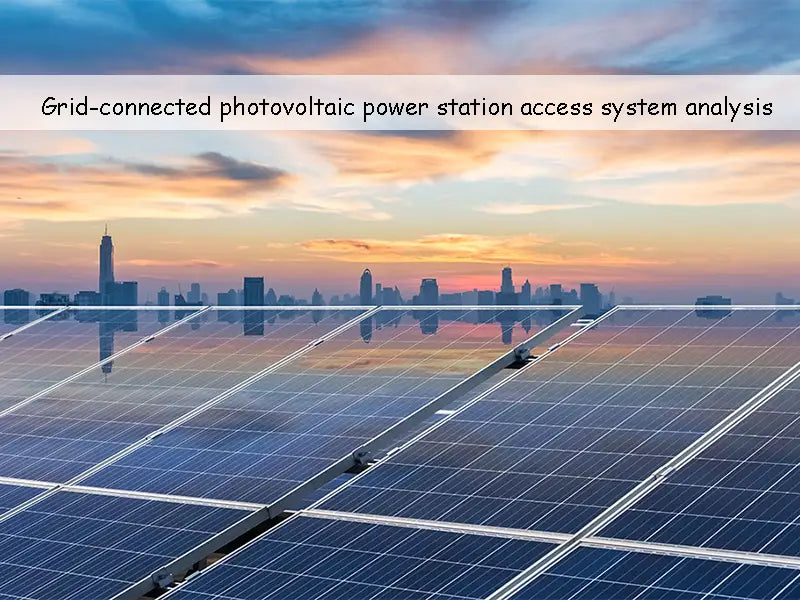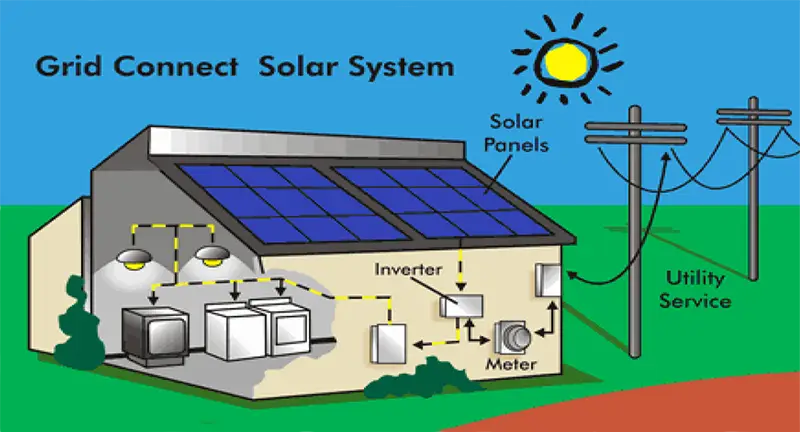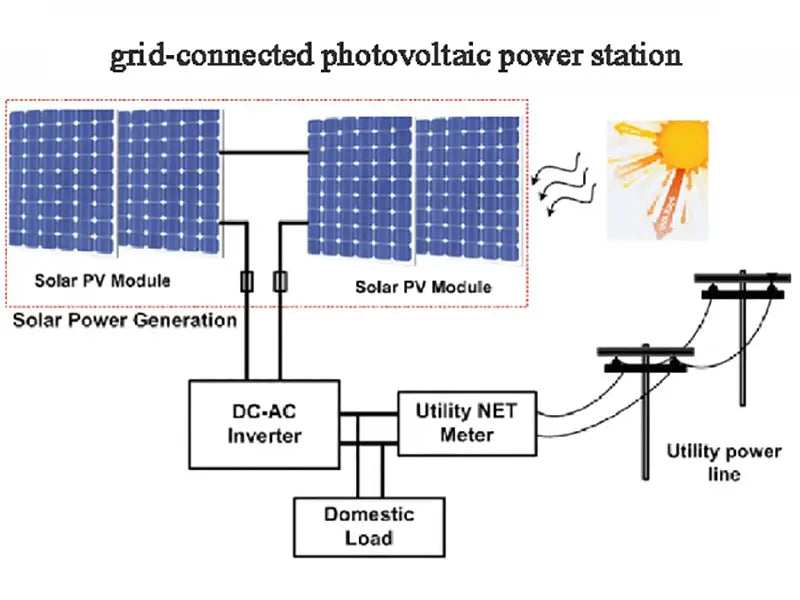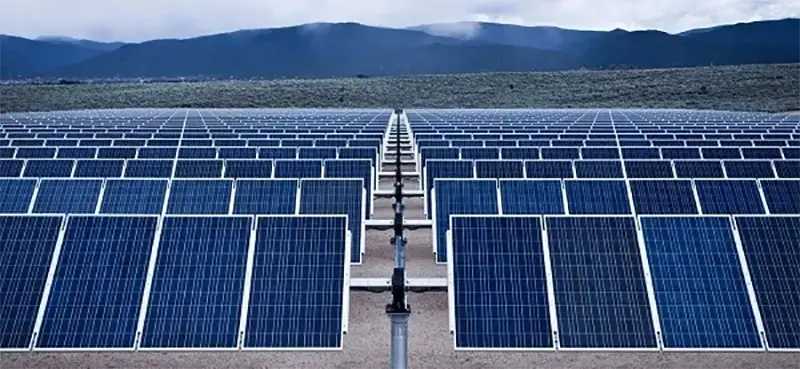
Main content:
- Grid flow and reactive voltage analysis after the grid connected photovoltaic power station is connected
- Grid connected photovoltaic power station access system analysis
- Power flow analysis
- Static Security Analysis
- Maximum receiving capacity under the limitation of power flow
- Suggestions and conclusions for grid connected photovoltaic power plants connected to the grid
1. Grid flow and reactive voltage analysis after the grid connected photovoltaic power station is connected
Taking the research on related technical issues of the grid-connected photovoltaic power station project in Qinghai Haixi as an example, the purpose is to evaluate the influence of the grid-connected photovoltaic power station on the local grid voltage, power flow, transient characteristics and power quality, and to propose feasible solutions. Solutions to ensure the safe and stable operation of the grid and grid-connected photovoltaic power plants.
When the output of Chaka grid-connected photovoltaic power station goes from zero to full power, the reactive power absorbed by the grid-connected photovoltaic power station gradually increases. If it changes within 10%, the change range is 0.017pu (per unit value, indicating the relative value of each physical quantity and parameter), and the change range of the 110kV bus voltage of the photovoltaic power station is about 0.013pu.
For the power grid, during the process of increasing the output of the Chaka grid-connected photovoltaic power station, the voltage of the 110kV busbar at the access point Haixi Ulan first increased and then decreased, and the maximum change range was about 0.001pu. The voltage of the Ulan 330kV busbar almost did not change. The connection of the Chaka grid-connected photovoltaic power station has very little impact on the grid voltage. Within the suitable range of the grid voltage, the voltage of each node will not exceed the voltage deviation range after the grid-connected photovoltaic power station is connected. In addition, since the output of the grid-connected photovoltaic power station in Chaka can carry a part of the Ulan load, as the output of the grid-connected photovoltaic power station increases, the 330kV Ulan power generation gradually decreases, and the active power of the Mingzhu-Ulan and Longyangxia-Ulan lines also increases. Showing a decreasing trend, it can be seen that the Chaka grid-connected photovoltaic power station has a certain optimization effect on the local power grid flow.

After analyzing the power flow and reactive voltage after the grid-connected photovoltaic power station is connected to the system, the main conclusions are as follows:
(1) Under the two load modes, each grid-connected photovoltaic power station has little impact on the local grid voltage after being connected to people, and the voltage variation at the access point does not exceed 0.01pu. Since the access points of grid-connected photovoltaic power station is all at low voltage levels of 110kV and 35kV, the photovoltaic output can be received locally, which is conducive to optimizing the power flow of the power grid.
(2) Under two load conditions, if the five planned grid-connected photovoltaic power plants are connected to the grid at the same time, when they increase in the same proportion, the impact on the grid voltage is also small, and it has a certain optimization effect on the power flow of the grid.
(3) Some lines of the Haixi Power Grid may cause the busbar voltage to decrease too much. After adjusting the high-voltage and low-voltage reactance or performing capacitive reactive power compensation, the voltage can be maintained within an appropriate range.
2. Grid connected photovoltaic power station access system analysis
2.1 Power flow analysis
Taking the grid-connected photovoltaic power station in Golmud City as an example, there are 3 photovoltaic power stations planned to be constructed in 2015, with a total capacity of 610MW, namely Daletan 300MW, Hedong Yichang 300MW and Golmud South Exit 10MW, Daletan and Hedong Farm are connected to the grid The installed capacity of the photovoltaic power station is relatively large. It is recommended to connect to Golmud City through the 330kV and 750kV lines respectively, and the grid-connected photovoltaic power station at the South Exit of Golmud is connected to the Guangming Substation through the 35kV line.
The impact of grid-connected photovoltaic power station in Golmud City on the power grid: Since the load flow under normal conditions is from Ulan to Golmud, the connection of grid-connected photovoltaic power station reduce the load rate of the 330kV and 750kV Ulan-Golmud lines, and makes the system voltage in Golmud. From the perspective of voltage deviation, the grid-connected photovoltaic power station can be installed without capacitive reactive power compensation device. It should be noted that it cannot cause the grid voltage to exceed the upper limit.

2.2 Static Security Analysis
Planning the access of grid-connected photovoltaic power plants will not lead to static safety and stability problems in the Golmud system.
2.3 Maximum receiving capacity under the limitation of power flow
The acceptance capacity of photovoltaic 35kV is mainly limited by capacity and is related to the load level of the transformer. In 2015, the capacity of photovoltaic main transformer was 50MV·A, and the maximum load was about 25MW. It is recommended that the installed capacity of photovoltaic power generation connected to the 35kV side should not be greater than 25MW.
The 330kV receiving capacity of Golmud City is mainly limited by the capacity of the main transformer in Golmud under the condition of power flow restrictions. In 2015, the capacity of the main transformer in Golmud City was 2100MV·A. The voltage also increases, and a reactor needs to be put in to reduce the voltage of the Golmud system; with the further increase of the output of the grid-connected photovoltaic power station, the trend of the Golmud substation has turned, from the power receiving system to the power transmission system, and the Golmud main substation and The load rate of the Wulan-Golmud line begins to rise. After the reactors are withdrawn one after another, capacitors need to be put in to maintain the voltage level of the Golmud system. The installed capacity of the grid-connected photovoltaic power station connected to the 330kV side of Golmud City should not exceed 3600MW. It should be noted that this value is only a limit to ensure that Golmud City and related lines do not have overload conditions. In fact, the limit of the temporary stability limit and the limit of the power grid peak shaving capacity must also be considered.
3. Suggestions and conclusions for grid connected photovoltaic power plants connected to the grid

(1) First, analyze the influence of the access of the planned grid-connected photovoltaic power station in each region on the power flow and reactive power voltage of the power grid, put forward the reactive power compensation scheme that each grid-connected photovoltaic power station needs to adopt, and plan the grid-connected photovoltaic power station to the grid static safety. , and the maximum reception capacity of each access point under power flow constraints. It should be noted that the proposed reactive power compensation scheme is only a general compensation scheme to meet the requirements of grid voltage deviation after the grid-connected photovoltaic power station is connected, and it is only to indicate whether the grid voltage will limit the access of the planned grid-connected photovoltaic power station. The actual grid-connected reactive power compensation scheme of the photovoltaic power station also needs to consider other factors such as voltage fluctuation and reactive power/power factor assessment at the grid-connected point.
(2) The access of all planned grid-connected photovoltaic power station will make the trend of the 750kV Riyueshan-Ulan-Golmud line reverse frequently. Golmud and Ulan areas are the receiving point network when the output is small, and the network is the receiving point when the output is large. Sending out the network increases the difficulty of voltage adjustment. When the grid-connected photovoltaic power station is running at a large output, the line load rate is relatively large, and the load rate of the 750kV Ulan city is increased, and the maximum can reach 60%. The analysis shows that the reactive power compensation scheme calculated based on each area cannot meet the grid voltage requirements after all planned photovoltaic power plants are connected, and the compensation scheme needs to be adjusted.
(3) In order to solve the disturbance to the grid voltage caused by the connection of all planned photovoltaic power plants, four schemes are considered:
①Adjust the original reactive power compensation scheme of grid-connected photovoltaic power station and increase the reactive power compensation capacity. Simulation analysis shows that only this method can not solve the problem of grid voltage deviation.
②On the basis of increasing the compensation capacity of the grid-connected photovoltaic power station, the automatic switching reactive power compensation device is installed in the 750kV Golmud and Wulan, where the photovoltaic power stations are connected more intensively, which can effectively reduce the change band of the output of the grid-connected photovoltaic power station. voltage fluctuations.
③Installation of SVC, compared with scheme 2, does not improve the grid fluctuation significantly, but on the basis of increasing the compensation capacity of the photovoltaic power station, installing SVC in 750kV Golmud and Ulan can obviously smooth the grid voltage fluctuation.
④If the large grid-connected photovoltaic power station is connected to the grid by voltage source, but the grid does not take other reactive power compensation measures, it will not be able to meet the grid voltage requirements, and it is necessary to install automatic switching compensation devices or SVC in 750kV Golmud City and Ulan.

In general, after all the planned grid-connected photovoltaic power station is connected, only reactive power compensation measures are taken in the photovoltaic power station, whether it is automatic switching, SVC, or grid-connected photovoltaic power station is connected to the grid by voltage source, all of which cannot be solved. The grid voltage fluctuation caused by large-scale power flow changes requires the installation of automatic adjustment reactive power compensation devices in the key nodes of the grid—750kV Golmud City and Ulan.
If the installed capacity of the grid-connected photovoltaic power station is only 1010MW in 2015, the busbar voltage level in the Haixi area can be increased without exceeding the upper limit, and there will be no need to install dynamic reactive power compensation devices at key nodes when the busbar voltage is reduced. The line load rate of the main network and the Hercynian area is reduced, which is conducive to reducing network losses, and at the same time, there will be no reverse line flow.
Read more: Research on the development sequence of photovoltaic power generation
















